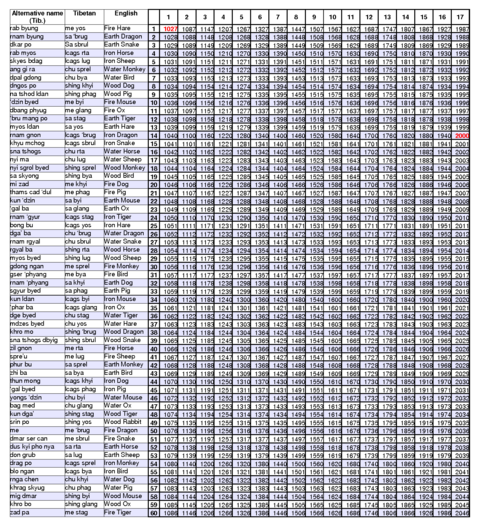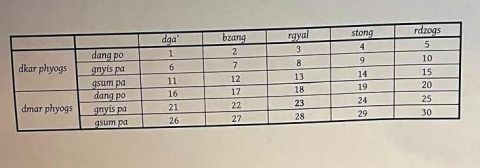Calendrical cycle

Calendrical cycle or Sexagenary cycle (Tib. རབ་བྱུང་, rabjung, Wyl. rab byung) — the sixty year cycle followed in the Tibetan calendar, which is a complete cycle according to Tibetan astrology.
Accordingly in the Tibetan system, years are identified by one of the 60 names formed with an element (earth, fire, water, wood, and iron) and an animal (hare, dragon, snake, horse, sheep, monkey, bird, dog, pig, mouse, ox, and tiger) identified, and the number of the sexagenary cycle. The first sexagenary cycle was in 1027 A.D. when this Tibetan dating system was instituted by Lotsawa Dawa Özer. We are now in the 17th cycle. So for example, the year 1959 was 'approximately' the Earth Pig year of the 16th cycle. 'Approximately' because the Tibetan New Year is usually somewhere between end of January and beginning of March. So the first days of January 1959 where still in the Earth Dog year of the 16th cycle (the 32nd year of a sexagenary cycle) while January 1960 was part of the Tibetan Earth Pig year (the 33rd year).
The Sixty Years
The 60 Names of the Indian 60-Year Cycle Calendar with Sanskrit Diacritics and Tibetan Equivalents
- Prabhava (རབ་བྱུང་, rab byung)
- Vibhava (རྣམ་བྱུང་, rnam byung)
- Śukla (དཀར་པོ་, dkar po)
- Pramoda (རབ་མྱོས་, rab myos)
- Prajāpati (སྐྱེས་བདག, skyes bdag)
- Āṅgirasa (མེ་, me)
- Śrīmukha (དཔལ་གདོང་, dpal gdong)
- Bhāva (དངོས་པོ་, dngos po)
- Yuvan (ན་ཆུང་, na chung)
- Dhātṛ (འཛིན་བྱེད་, 'dzin byed)
- Īśvara (དབང་ཕྱུག, dbang phyug)
- Bahudhānya (འབྲུ་མང་, 'bru mang)
- Pramāthin (རབ་བཙན་, rab btsan)
- . Vikrama (རྣམ་གནོན་, rnam gnon)
- Vṛṣa (ཁྱུ་མཆོག, khyu mchog)
- Citrabhānu (སྣ་ཚོགས་འོད་, sna tshogs 'od)
- Subhānu (དགེ་བྱེད་, dge byed)
- Tāraṇa (སྒྲོལ་བ་, sgrol ba)
- Pārthiva (ས་སྐྱོང་, sa skyong)
- Vyaya (རྣམ་འགྱུར་, rnam 'gyur)
- Sarvajit (ཀུན་འཛིན་, kun 'dzin)
- Sarvadhārin (ཀུན་བཟུང་, kun bzung)
- Virodhin (འགལ་བ་, 'gal ba)
- Vikṛti (རྣམ་འགྱུར་, rnam 'gyur)
- Khara (བོང་བུ་, bong bu)
- Nandana (དགའ་བ་, dga' ba)
- Vijaya (རྣམ་རྒྱལ་, rnam rgyal)
- Jaya (རྒྱལ་བ་, rgyal ba)
- Manmatha (ཡིད་སྲུབས་, yid srubs)
- Durmukha (གདོང་ངན་, gdong ngan)
- Hemalamba (གསེར་འཛིན་, gser 'dzin)
- Vilamba (ཟུར་ཕུད་, zur phud)
- Vikārin (རྣམ་འགྱུར་, rnam 'gyur)
- Śārvari (སརྦ་རི་, sar+ba ri)
- Plava (རྒྱུ་བ་, rgyu ba)
- Śubhakṛt (དགེ་བྱེད་, dge byed)
- Śobhana (མཛེས་བྱེད་, mdzes byed)
- Krodhin (ཁྲོ་བ་, khro ba)
- Viśvāvasu (ཀུན་འབྱོར་, kun 'byor)
- Parābhava (ཕམ་བྱེད་, pham byed)
- Plavaṅga (སྤྲེའུ་, spre'u)
- Kīlaka (ཕུར་བུ་, phur bu)
- Saumya (ཞི་བ་, zhi ba)
- Sādhāraṇa (ཐུན་མོང་, thun mong)
- Virodhakṛt (འགལ་བྱེད་, 'gal byed)
- Paridhāvin (ཡོངས་འདེགས་, yongs 'degs)
- Pramādin (བག་མེད་, bag med)
- Ānanda (དགའ་བ་, dga' ba)
- Rākṣasa (སྲིན་པོ་, srin po)
- Nala (ཤིང་, shing)
- Piṅgala (སེར་སྐྱ་, ser skya)
- Kālayukta (དུས་ལྡན་, dus ldan)
- Siddhārtha (དོན་གྲུབ་, don grub)
- Raudra (དྲག་པོ་, drag po)
- Durmati (བློ་ངན་, blo ngan)
- Dundubhi (རྔ་ཆེན་, rnga chen)
- Rudhirodgārin (ཁྲག་སྐྱུག, khrag skyug)
- Raktākṣa (མིག་དམར་, mig dmar)
- Krodhana (ཁྲོ་བོ་, khro bo)
- Kṣaya (ཟད་པ་, zad pa)
This 60-year cycle (ṣaṣṭi-saṃvatsara) is traditionally used in Indian calendrical systems, particularly in the Jovian cycle (Bṛhaspati cycle) that tracks the orbital motion of Jupiter. This cycle (ལོ་སྐོར་དྲུག་ཅུ་, lo skor drug cu) combines with the twelve-animal cycle (བཅུ་གཉིས་, bcu gnyis) and the five elements (འབྱུང་བ་ལྔ་, 'byung ba lnga) in Tibetan calendrical calculations.
Other Notes on Months and Days

Twelve Months
- Māgha (mchu zla ba)
- Phālguna (dbo zla ba)
- Caitra (nag pa zla ba)
- Vaiśākha (sa ga zla ba)
- Jyeṣṭha (snron zla ba)
- Āṣādha (chu stod zla ba)
- Śrāvaṇa (gro bzhin zla ba)
- Bhādra (khrums stod zla ba)
- Aśvinī (dbyug pa zla ba; tha skar zla ba)
- Kṛttikā/ Kārttika (smin drug zla ba)
- Mārgaśīrṣa (mgo zla ba)
- Puṣya (rgyal zla ba)
Sanskrit for month is māsa.
Further Reading
- Alaka Chattopadhyaya, Tibetan Chronological Tables of Jam-dbyaṅs bźad-pa and Sum-pa mkhan-po, Varanasi: CIHTS, 1993
External Links
- Tibetan calendars for the years 1450-2049 according to the Tsurphu tradition
- Tibetan calendars for the years 1450-2049 according to the Phugpa tradition Note: The phugpa tradition is the calendrical system followed by the Rigpa Tibetan Calendar.
- Tibetan and Western Years Correspondence Table by Esukhia